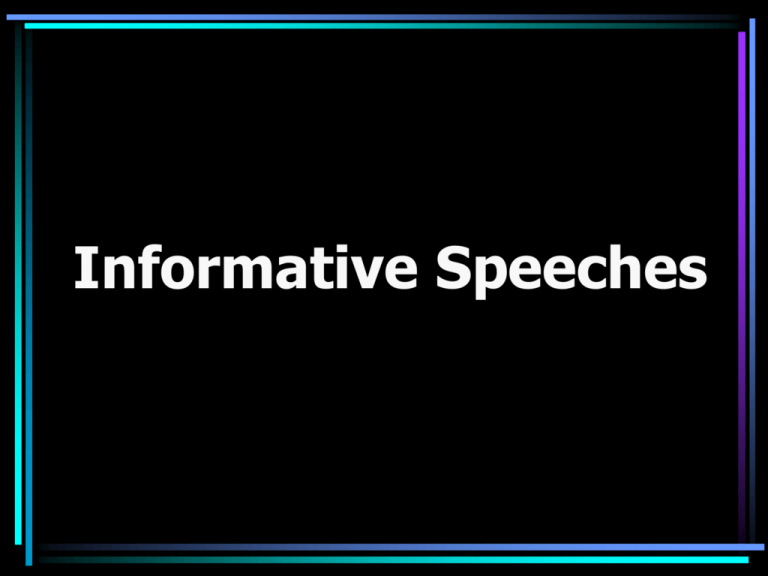Informative Speeches Informative Speech
advertisement

Informative Speeches Informative Speech: Purpose • Information is new knowledge that the listener will in some way add to the some dimension of self (social, intellectual, physical, economical, moral, and/or spiritual) that he/she wants to develop. • Giving and receiving information is a major reason we communicate with one another. Informative Speeches: Real World Examples • Public Lecture: Speaker is asked to give information because of his/her expertise in a given area. • Status Report: Used by business professionals to update the company’s executives of ongoing projects. • Briefing: often used by the government to inform citizens of events. Ex. Updates on the War in Iraq • Sermons: religious informative speeches that deliver God’s message to parishioners The Six C’s of Informative Speaking 1. Be Clear: Define and explain important terms for the audience. Make distinctions by saying not only what something is, but also what it is not. Example: Topic- Fraternal Twins • Fraternal Twins are two siblings who were born during the same period of labor (often within minutes). • Fraternal Twins are not the same as identical twins, who are created from the same fertilized egg splitting into two sections. Instead, fraternal twins created from two different eggs that have been fertilized by two separate sperm. The Six C’s of Informative Speaking 2. Be Concise: Make each word count by using precise and specific language. Don’t say the same thing twice, unless to reiterate an important point. – Examples: • Don’t use the word tree when you mean to say oak. • Don’t say things such as “She arrived at 8 a.m. this morning” The Six C’s of Informative Speaking 3. Be Complete: While no speech will cover all the possible material about your topic, you should create a sense of completion in the minds of your audience by raising certain expectations and then satisfying them. Example • In your introduction, introduce your three major points you will discuss. When you begin talking about your first point, say “First” so they audience knows you are at the beginning. Also consider using “Next” and “Finally” for your other major points. The Six C’s of Informative Speaking 4. Be Correct: Check the accuracy of your information. Make sure all sources are credible and provide documentation of your sources in your outline. During your speech, just reveal the name of your source. – Example: “The National Institute on Drug Abuse states …” MLA Documentation of Sources • Book: Last name, First name. Title. Publication City: Publication Company, Year. • Encyclopedia or Dictionary: “Title of article or entry.” Title of Encyclopedia or Dictionary. 15th ed. Year. MLA Documentation of Sources • Magazine article: Last name, First name. “Article title.” Magazine. Feb. Year: Page numbers. • Website: Last name, First name of creator. Name of website. 14 May 2004. 6 Nov. 2006. <http://www.webaddress>. The Six C’s of Informative Speaking 5. Be Concrete: Focus on the immediate and the actual. Individual cases are much more interesting that generalizations. – Example: Topic- The Women’s Movement • Don’t say that a lot of women were involved. Instead, tell us about Gloria Steinem and her involvement. The Six C’s of Informative Speaking 6. Connect: Analyze the people in your audience and find out what they might want to know more about. Make your speech interesting for them by choosing a topic that relates to them in some way. Don’t do an informative speech on something we can assume they already know. • Example: Don’t give a speech on how to say the ABC’s. Turning a Subject into a Speech • Preparation: – Select a subject (broad area of knowledge such as soccer or punk music). – Narrow your subject. In the case of punk music, focus your speech on a specific band such as The Used. – Research your subject. Use credible sources! Turning a Subject into a Speech • Format of speech: • Follows same outline format of any other extemporaneous speech. –Attention Getter, Significance, Credibility, Thesis, Preview, Point 1 and supporting facts, Point 2 and supporting facts, Point 3 and supporting facts, Restate thesis, Strong final statement Visual Aids • Helpful when giving specific information such as poll results, statistics, or instructions. • May be used at any time in the speech, but must be kept hidden until you are ready to use. • Make sure visual aid is large enough for everyone in audience to see!






